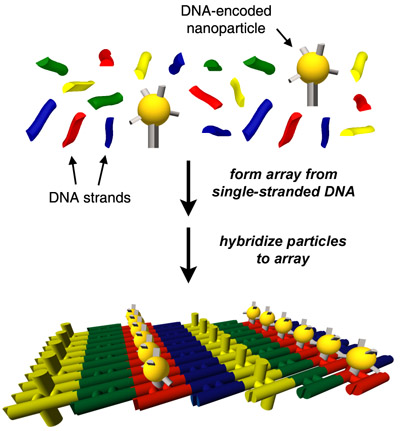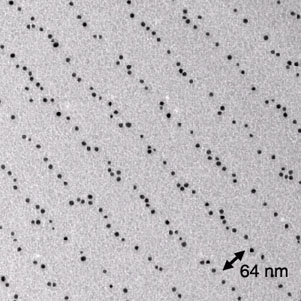
Recent Research Developments
The quantized electronic and magnetic behavior of some metallic, semiconducting and magnetic nanoparticles have naturally led scientists to envision these materials as components in a whole new generation of nanocircuitry. For example, monodomain magnetic nanoparticles would be the smallest possible "bits" in 2-D magnetic memory, and metal and semiconductor nanoparticles could be arranged into nanotransistors and quantum logic arrays that would allow already tiny devices to be miniaturized even further. However, manufacturing these devices using current technologies would be prohibitively expensive, and sometimes impossible. To capitalize on advances in nanoelectronics, we will need to develop new manufacturing methods in which complex nanostructures spontaneously assemble themselves, using instructions that have been pre-encoded into individual nanocomponents.
Towards this end, graduate student John Le and postdoctoral fellow Yariv Pinto, working with Professors Karin Musier-Forsyth, T. Andrew Taton, Richard Kiehl (UMN Electrical & Computer Engineering), and Nadrian Seeman (NYU Chemistry), have reported that DNA molecules can be used to spontaneously assemble nanoparticles into two-dimensional arrays (Nano Letters, in press). In this scheme, an interwoven scaffold of double-stranded DNA with regularly-spaced, single-stranded "sticky ends" recognize nanoparticles that have complementary single strands attached. Nanoparticles that aren't functionalized with DNA, or that bear other, non-complementary DNA sequences, are not assembled; this shows that the assembly is specifically encoded by the DNA on the array and the particles. So far, this approach has been applied to arrays of 5 nm and 10 nm diameter gold nanoparticles spaced by tens of nanometers. In the future, we plan to array different nanoparticle materials, to modify the arrays post-assembly to synthesize nanowires and nanogrids, and to characterize electronic properties and addressing of array components.

Scheme for arraying nanoparticles on a DNA scaffold. The array forms and the particles organize spontaneously in water, under DNA hybridization conditions. Each cylinder in the cartoon represents a DNA duplex, and each color represents different "tiles" made from 5-7 single DNA strands.

Transmission electron microscope (TEM) image of an array of 5-nm-diameter gold nanoparticles. In total, 21 different DNA sequences were used in this array; even though the complexity of assembly for these strands is high, the array is regular over many square microns.
Next scheduled update: Oct 27th, 2004.
Copyright 2004 by the Regents of the University of Minnesota.For questions or comments, contact the Chemistry Webmaster or read the University's Online Privacy Statement.